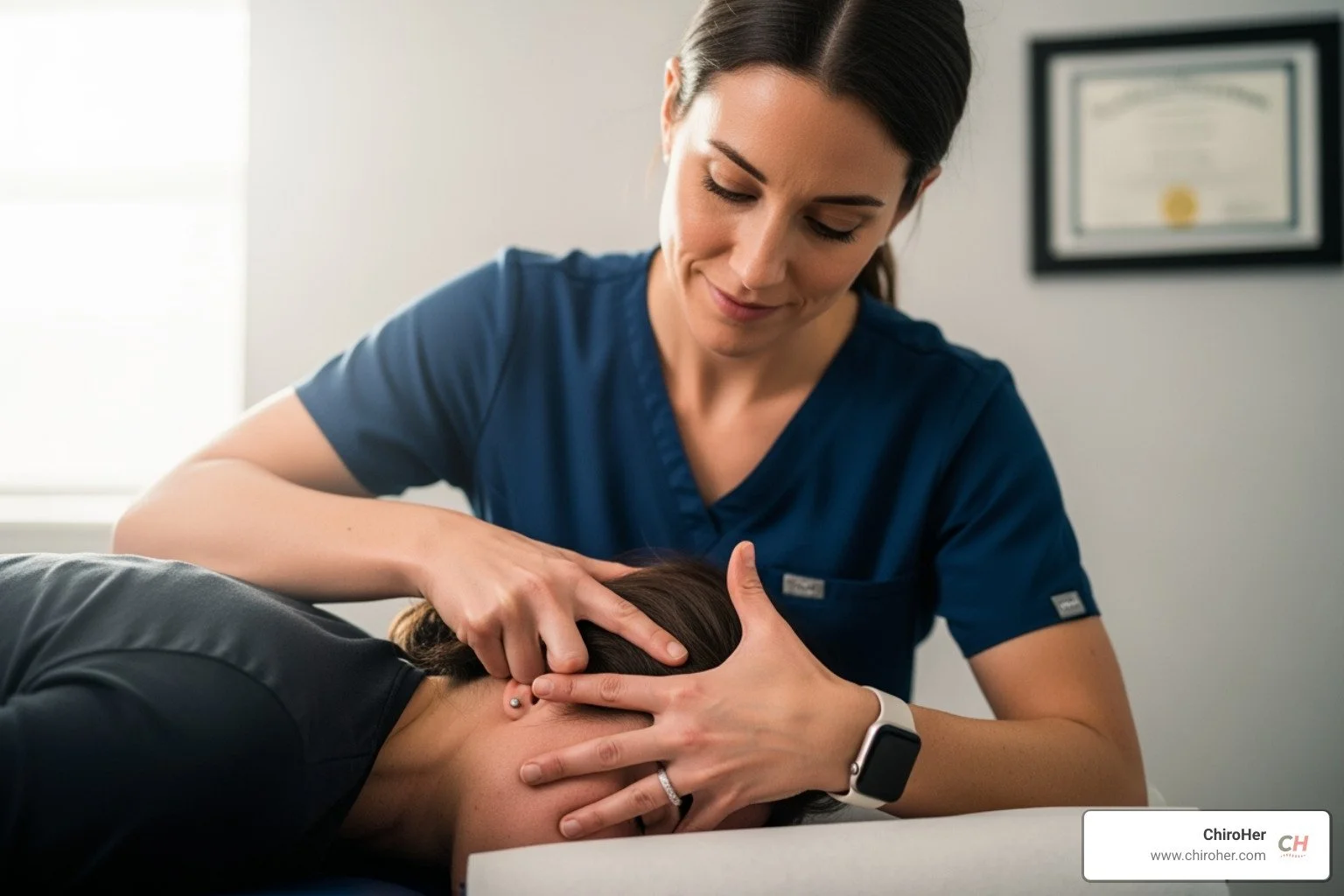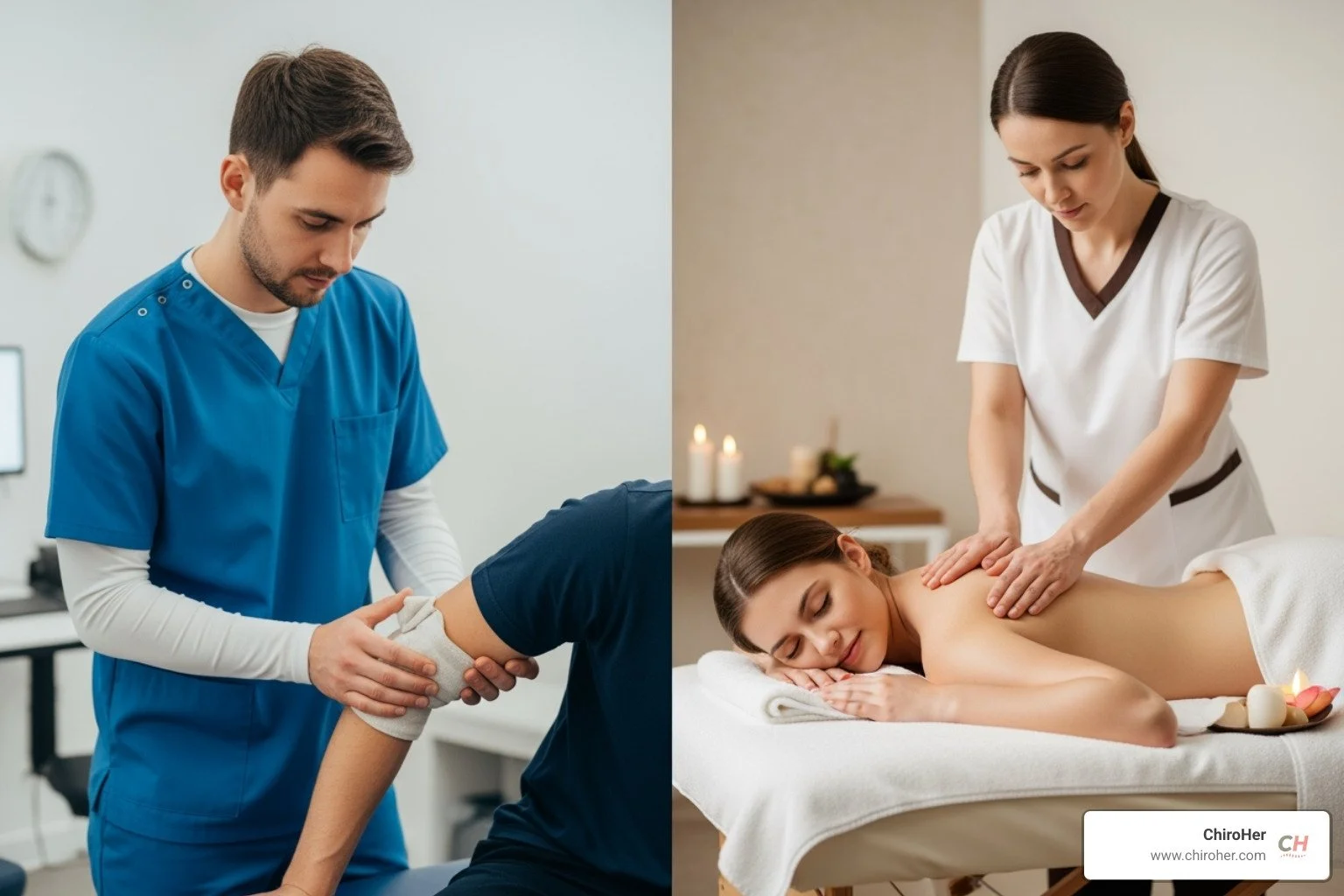Beyond the Rub: What Sets Manual Therapy Apart from Massage?
Understanding the Confusion Around Hands-On Healing
Is manual therapy the same as massage therapy? The short answer is no. While both involve hands-on treatment, they serve different purposes and require different levels of training.
Quick Answer:
Manual therapy = Clinical treatment by licensed physical therapists or chiropractors to restore function and treat musculoskeletal dysfunction.
Massage therapy = Soft tissue manipulation by licensed massage therapists focused on relaxation, stress relief, and general wellness.
Key difference = Manual therapy targets specific joint and tissue problems; massage therapy promotes overall relaxation.
Many people use these terms interchangeably, but this can lead to getting the wrong type of care. As one physical therapy clinic noted: "One common misconception of physical therapists is that they offer massage during treatment. Many use manual therapy and massage therapy interchangeably. However, physical therapists provide manual therapy to patients, not massage."
Choosing the right approach can mean the difference between addressing the root cause of your pain versus only getting temporary relief. Manual therapy diagnoses and treats specific musculoskeletal issues, while massage therapy emphasizes relaxation and general muscle tension relief.
Hi! I'm Dr. Michelle Andrews, and through my work at ChiroHer helping hundreds of patients with back pain, sports injuries, and prenatal care, I frequently encounter questions about this topic. Understanding this difference is key to helping my patients choose the most effective treatment for their conditions.
Is Manual Therapy the Same as Massage Therapy? A Detailed Comparison
While both manual therapy and massage therapy involve hands-on healing, they operate on different principles with distinct goals. Understanding these differences is key to making informed health decisions. One is a targeted clinical intervention, while the other focuses on general wellness and relaxation.
What is Manual Therapy?
Manual therapy is a specialized treatment using hands-on techniques to manipulate muscles, joints, and soft tissues. It's a precise, skilled approach designed to regain movement, activate muscles, and reduce inflammation. This requires advanced training in human anatomy and physiology.
The primary goals are to reduce pain, improve mobility, and restore function by addressing the root cause of musculoskeletal dysfunctions. This can involve restoring joint mobility, improving posture, breaking up scar tissue, and increasing your range of motion.
At ChiroHer, our chiropractic care often incorporates manual therapy to provide targeted relief and promote healing. It is recommended for a wide range of conditions involving pain, stiffness, or limited movement, including:
Chronic back and neck pain
Muscle tension in the neck and shoulders
Joint mobility issues and stiffness, such as arthritis
Headaches and migraines
Lymphedema, through manual lymphatic drainage
Jaw pain and whiplash
Mid-back pain and shoulder blade pain
Pelvic pain
Herniated discs and degenerative disc disease
Tennis elbow, fractures, and rotator cuff pain
Pain from joint replacements or ankle sprains
Post-operative recovery
For more detailed information, you can explore our page on More info about Manual Therapy. The effectiveness of manual therapy for conditions like back pain is also supported by scientific research, as highlighted in this Scientific research on manual therapy for back pain.
What is Massage Therapy?
In contrast, massage therapy involves manipulating the body's soft tissues with techniques like kneading and stroking. It's typically geared toward reducing tension and stress, promoting circulation, and fostering overall relaxation.
Its primary goals are broader and less focused on specific dysfunctions. These goals include:
Relaxing muscles and relieving general soreness
Improving circulation
Promoting a sense of well-being
Reducing stress and anxiety
Improving sleep quality
Massage therapy is often sought for general wellness, stress reduction, or recovery after physical exertion, rather than as a primary treatment for specific injuries. For a deeper understanding, you can refer to information on Massage therapy for health.
Education and Qualifications: A Critical Distinction
The most significant difference lies in the practitioners' education and qualifications.
Manual therapy is performed by state-licensed physical therapists and chiropractors. These professionals undergo extensive, higher-level education, such as a Master's or Doctorate of Physical Therapy (DPT) or a Doctor of Chiropractic (DC) degree. This rigorous training equips them to conduct thorough evaluations, diagnose specific musculoskeletal conditions, and develop targeted treatment plans.
Massage therapists are state-licensed professionals who have completed a diploma or certificate from an accredited program, which typically includes around 600 hours of training and supervised practical experience. Their training focuses on soft tissue manipulation techniques, client communication, and understanding general contraindications for massage. This level of training does not typically include the in-depth diagnostic skills required for treating complex musculoskeletal dysfunctions.
To summarize the differences:
Feature Manual Therapist (Chiropractor/Physical Therapist) Massage Therapist Education Master's or Doctorate Degree (DPT or DC) Diploma or Certificate (approx. 600 hours) Licensing State-licensed PT or DC State-licensed Massage Therapist (LMT) Training Focus Advanced anatomy, biomechanics, pathology, diagnosis, clinical reasoning Soft tissue manipulation, relaxation, general wellness Assessment Comprehensive evaluation and diagnosis of musculoskeletal dysfunction Focus on client-identified areas of tension
This table illustrates that while both professions involve working with the body, their knowledge, diagnostic capability, and clinical scope differ significantly.
Common Techniques for Manual and Massage Therapy
Both therapists use a variety of hands-on techniques, but the application and intent are distinct.
Common Manual Therapy Techniques: Manual therapists use a diverse set of techniques aimed at restoring proper movement and function. These include:
Soft Tissue Mobilizations: Applying deep pressure and stretching to muscles, ligaments, and fascia to break down adhesions and optimize muscle function.
Joint Mobilizations: Using skilled, graded force to apply gentle movements that increase range of motion in stiff or sore joints.
Myofascial Release: Applying gentle, sustained pressure to release restrictions in the connective tissue that supports muscles and bones.
Thrust Manipulation: A targeted high-velocity, low-amplitude thrust to a joint to restore normal movement and relieve pain, often associated with chiropractic care. Learn more in our Complete Guide to Spinal Adjustments.
Muscle Energy Techniques (MET): The patient actively contracts muscles against a therapist's resistance, followed by passive stretching to lengthen shortened muscles.
Manual Traction: Applying a gentle, sustained pulling force to the spine or limbs to decompress joints.
Cupping: Using silicone cups to create suction on the skin, which lifts tissue to improve blood flow and reduce pain.
Strain-Counter-Strain: A gentle technique of mild stretching and rest periods to relax tight muscles and reduce spasms.
Dry Needling: Inserting thin needles into muscle trigger points to release tension and pain.
Lymphedema Therapy: A specialized technique to remove excess fluid from an affected area.
For more on specific techniques, visit our pages on What is Trigger Point Therapy? and Fascial Strain Counterstrain.
Common Massage Therapy Techniques: Massage therapists focus on techniques for relaxation and general well-being. These often include:
Swedish Massage: Long, flowing strokes, kneading, and tapping for general relaxation.
Deep Tissue Massage: Slower, more forceful strokes targeting deeper layers of muscle and connective tissue to treat chronic pain.
Sports Massage: Customized for athletes to prevent injuries and improve recovery.
Trigger Point Massage: Applying sustained pressure to "trigger points" or knots in muscles.
While physical therapists might use soft massaging techniques, their ultimate goal is much more specific than that of a massage therapist.
Making the Right Choice for Your Body
Now that we've explored the key differences, how do you choose the right approach? Both manual therapy and massage therapy have their place; it's about matching the treatment to your specific needs and goals.
Choosing the Right Hands: Is manual therapy or massage therapy better for you?
The answer to this question becomes clearer when you consider what your body is telling you. Your symptoms and goals will guide you to the most effective treatment.
Manual therapy is your best bet if you are:
Dealing with chronic pain that limits your daily activities.
Experiencing joint stiffness or noticing that certain movements feel wrong.
Recovering from an injury, such as a sprain, pulled muscle, or surgery.
Diagnosed with a condition like sciatica, a herniated disc, or carpal tunnel syndrome.
At ChiroHer, our Chiropractic Care services focus on these situations. We are trained to identify the cause of your pain and create a treatment plan that addresses the root problem.
Massage therapy shines if you are looking for:
Stress relief and overall relaxation.
Relief from muscle tightness from sitting, working out, or daily tension.
Improved circulation and reduced general muscle soreness.
A way to maintain good muscle health and manage everyday stress.
If you are not dealing with a specific injury but want to support your well-being, massage therapy is an excellent choice for regular self-care.
Can Manual Therapy and Massage Therapy Be Used Together?
You don't always have to choose just one. Manual therapy and massage therapy can work well together as part of a comprehensive wellness plan.
This integrated approach can be very effective. For example, a manual therapist can provide structural correction by fixing a misaligned joint, while massage therapy can aid muscle recovery by reducing surrounding tension and improving blood flow. By addressing both the specific dysfunction and general muscle tension, you can often achieve a faster, more complete recovery.
At ChiroHer, we accept a holistic approach to healing. We understand that every person's body is unique, and the best results sometimes come from combining different treatment methods. We create personalized plans that make sense for your situation.
If you're curious about how these therapies might work together for you, we can help you figure it out. Schedule a consultation to discuss your needs and we can explore the best path forward.
This guide is for informational purposes and is not a substitute for already established medical advice from your healthcare provider.




